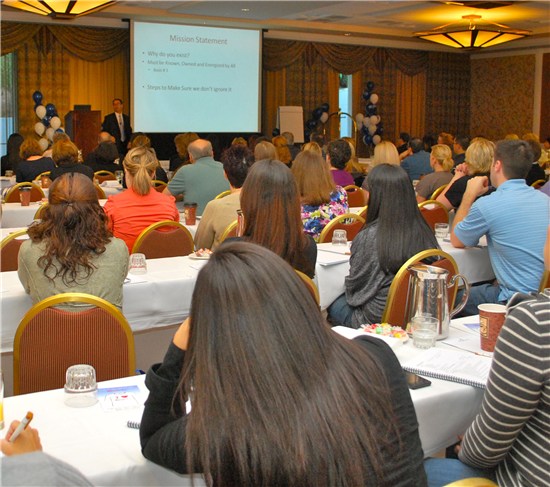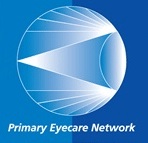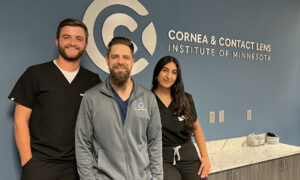By Kenneth Sakazaki, OD
SYNOPSIS
Investing in continuing education for office staff pays off in improved service to patients and an enhanced practice brand. Incentivize your staff by providing education stipends.
ACTION POINTS
PROVIDE CE STIPENDS. Offer each employee a stipend to be used for CE.
HAVE STAFF PAY FOR CERTIFICATION. Pay for CE, but have staff pay to take certification tests with higher pay after attaining certification.
SET LEARNING GOALS FOR NEW EMPLOYEES. Identify areas for improvement, help employees select courses.
In photo: Primary Eyecare Network (PEN) sponsoring a CE course at a recent symposium.
In our practice, we believe in investing in continuing education for our staff, which consists of three employees. Over the years, the investment we have made in staff CE has paid off in improved patient service and an enhanced practice brand. The practice management and purchasing organization I work with, Primary Eyecare Network (PEN), makes providing this education easy and affordable with diverse courses to choose from that my staff can fit into their busy schedules.
 In addition to education programs, PEN offers practice management services and group purchasing benefits.
In addition to education programs, PEN offers practice management services and group purchasing benefits.
Find out more at www.PrimaryEye.net.
Set Budget for Continuing Education
Each of our three full-time employees has a $300 per-year allowance to use toward the continuing education (CE) of their choice. After seven years of employment, the allowance increases to $500 per year. If we, as practice owners, feel a specific course is necessary, we simply pay for it without requiring the employee to use their CE stipend for it . The stipend is for development employees determine on their own is necessary, but the the practice supplements this for any training we feel is a must.
Practice Pays for CE,Staff Pays for Certification
Certification is recommended when applying to our office, but is not required. If a staff member wants to attain certification, they must pay the test fee, with the understanding that they will be paid more once certified. We help with the CE leading up to the test.
Sacramento Optometric Group
KennethSakazaki, OD
University of California-Berkeley School of Optometry
Class of 1986
Practice history: Practice established in 1931; Dr. Sakazaki joined as a partner in 1986 and is the third owner of the practice.
Locations: 1
ODs: 3
Comprehensive exams annually: 5,000
Annual revenues: Over $1 million
Set Learning Goals for Each New Employee
When we hire new employees, we set learning goals or pre-determined areas of improvement. For instance, if we hire a new optician who says she would like to get more familiar with handling prescriptions for personalized lenses, we would encourage her to use her CE stipend take courses that address that area; or if we have another staff member who would like to get more involved with the pre-testing process, we might direct her to courses in that area.
Expand Employee Potential
We felt that one of our optometric assistants, Erica, had a lot of potential, so we sent her to a special program to broaden her knowledge and prepare her for the AOA Paraoptometric Certification course. The PEN course Erica took cost our practice around $500. Since this is a course we chose for her to attend, it did not count against her allowance for the year. We do not measure optical sales for Erica individually, but her confidence interacting with patients has improved, as well as her communication with the doctors.
In addition, we always send our biller and office manager to the PEN John McGreal Billing and Coding seminar, which costs $160 per person to attend. The practice pays for this and it does not count against the employee’s stipend.
Another course I send my office manager to is the PEN Office Leaders Series. This series is given over three separate days over the year. This year’s topics: “Office Leader Must-Do’s” was in March, “Preparing Your Team for Excellence” was in July, and “Putting Leadership Into Action” is upcoming in November.
This series, which costs $450 in total or $200 for each separately, is valuable because of the back and forth sharing of ideas with managers and office leaders from other practices.
Related ROB Articles
Lessons for the Optometric Practice from Ritz-Carlton
Front Desk Training: Prepare Staff for Challenging Conversations
Staff Retreats: Focus on Goals to Enhance Patient Care and Revenues
 Kenneth Sakazaki, OD, is the owner of Sacramento Optometric Group in Sacramento, Calif. To contact: ksakazaki@comcast.net
Kenneth Sakazaki, OD, is the owner of Sacramento Optometric Group in Sacramento, Calif. To contact: ksakazaki@comcast.net



























